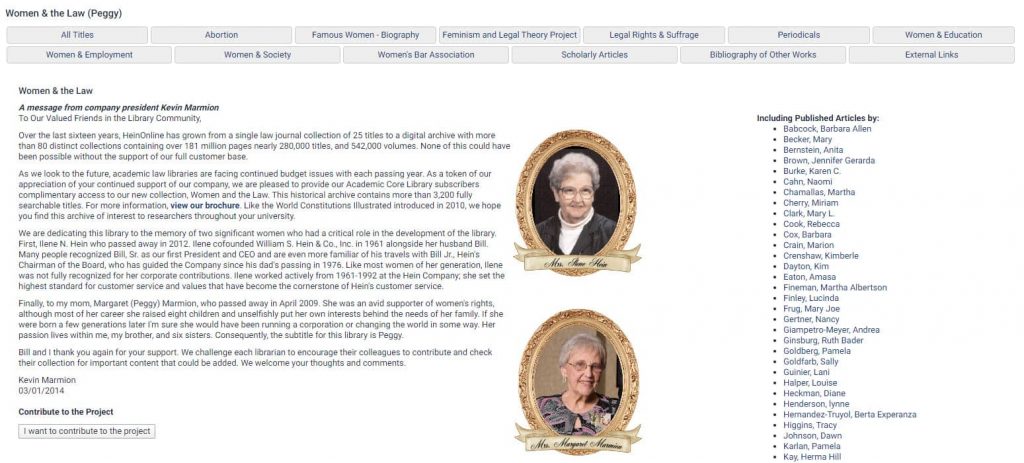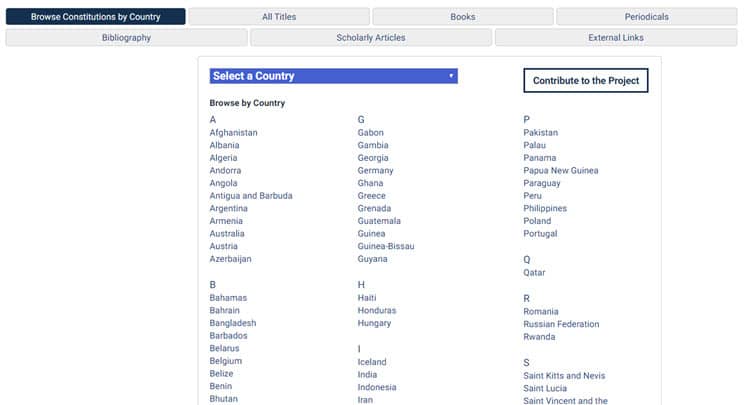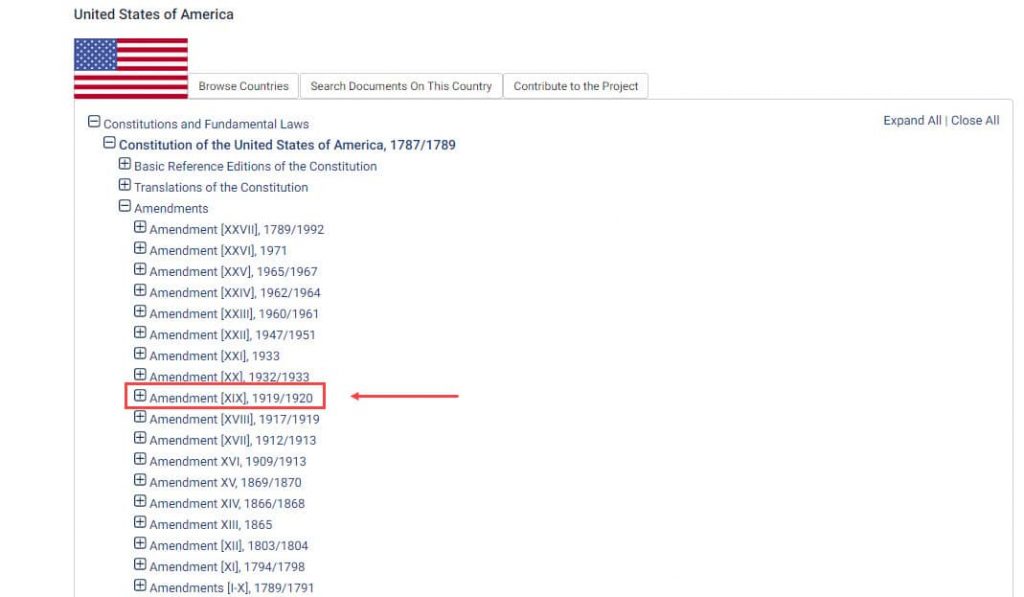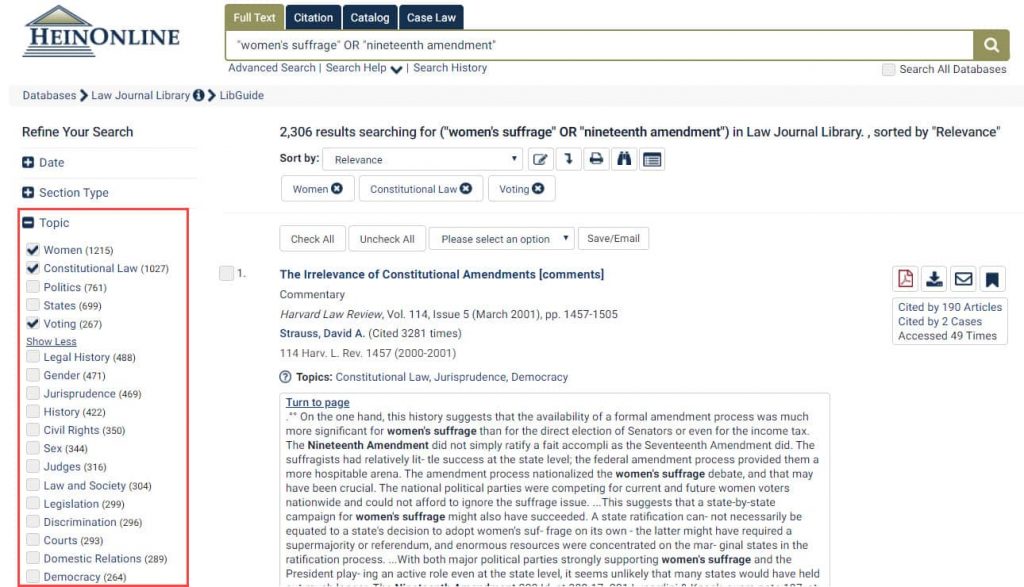In 1914, a constitutional amendment for women’s suffrage—nicknamed the “Susan B. Anthony Amendment,” after one of its most ardent supporters—was considered by the Senate. The proposed amendment followed more than a half-century’s fight for legal recognition of the female right to vote, decades of which were characterized by suffragist conventions, parades, and arrests across the country. After numerous rejections, the proposal was finally passed in June of 1920 and ratified as the 19th Amendment on August 18th of the same year.
Today we celebrate 100 years since that historic day, and right on the heels of the third female vice-presidential pick by a major American political party in history. To celebrate the political progress of American women over the past century, let’s take a look at where it all began. Join HeinOnline as we outline four ways to research the women’s suffrage movement and the 19th Amendment.
1. Research women’s suffrage in HeinOnline’s Women and the Law.
Start your study with HeinOnline’s Women and the Law database, a collection of books, biographies, and periodicals which illuminate the progression of women’s roles and rights in society over the past 300 years.

Within Women and the Law, find an entire subcollection dedicated to Legal Rights & Suffrage, containing more than 800 works relating to the suffrage movement and other rights. Relevant titles include Case for Women’s Suffrage, written thirteen years before the ratification of the 19th Amendment and available exclusively in this database.
Move on to the Famous Women subcollection to peruse nearly 150 biographies of notable women who contributed to the progression of women’s rights. Titles include the Life and Work of Susan B. Anthony: Including Public Addresses, Her Own Letters and Many from her Contemporaries during Fifty Years.
For more information on using HeinOnline’s Women and the Law, visit our dedicated LibGuide.
2. Find the 19th Amendment in World Constitutions Illustrated.
Brush up on your knowledge of the 19th Amendment by taking a look at the original source. To do so, navigate to HeinOnline’s World Constitutions Illustrated database, a collection of constitutions and political documents for every country in the world, including the United States.

Select “United States of America” from the blue drop-down box at the top of the country list. From the following page, select “Constitutions and Fundamental Laws” and then “Constitution of the United States of America” to bring up a list of amendments to the U.S. Constitution.

Click on Amendment XIX to view a true-to-print searchable image of the 19th Amendment.
For more on World Constitutions Illustrated, check out the database’s dedicated LibGuide.
3. Locate historical women’s suffrage resources in the U.S. Congressional Serial Set.
The U.S. Congressional Serial Set is the official historical record of the U.S. government as it experienced every event in American history, including the women’s suffrage movement and the passage of the 19th Amendment. Navigate to HeinOnline’s digitized version of this essential resource to find primary source documents relating to these two topics.
Perform a search for “woman suffrage” in this database to bring up a list of relevant congressional reports, hearings, and more, including these primary sources demonstrating the historical development of the amendment:
- Report of Committee on Woman Suffrage on joint resolution proposing amendment to Constitution of United States (1884)
- Hearings on woman suffrage, proposed amendment to Constitution (1911-1912)
- Woman Suffrage: Reports and hearings relative to Joint Resolutions (1913)
- Constitutional amendment for woman suffrage (1913)
- Woman suffrage (1916)
- To grant right of woman suffrage, with minority report (1917)

Also to be found are the words of suffragettes themselves in favor of amending the Constitution (including an extended speech from Susan B. Anthony). Check them out in Arguments of woman-suffrage delegates before Committee on Judiciary of Senate (1882).
For more information about researching Susan B. Anthony’s life, work, arrest, and trial in the Serial Set, peruse this blog post. Take a look at the U.S. Congressional Serial Set LibGuide below for more helpful search tips and tricks.
4. Discover authoritative secondary sources in the Law Journal Library.
For scholarly discussion and analysis of the women’s suffrage movement, the 19th Amendment, and the progression of women’s rights, users can also turn to HeinOnline’s Law Journal Library, a collection of more than 2,800 multidisciplinary journals. Through sophisticated machine learning, content within this database has been assigned relevant topics to make searching any subject a breeze.
To start, perform a general full-text search for “women’s suffrage” OR “nineteenth amendment” which will generate a broad list of more than 6,700 results. Using the facets on the left-hand side of the search results, narrow the query by selecting as many relevant topics as desired. We’ve chosen the topics of “Women,” “Constitutional Law,” and “Voting” to limit the search to a more manageable 2,306 entries.

Relevant titles from this search include:
- The Nineteenth Amendment and Women’s Equality (1993)
- The History of the Women’s Suffrage Movement (1996)
- Politics and Mythology in the Early Women’s Rights Movement (2017)
- Why the Nineteenth Amendment Matters Today: A Guide for the Centennial (2020)
- Looking at the Nineteenth Amendment through a Twenty-First Century Lens (2020)
Utilize the Law Journal Library LibGuide below for more information about its unique search tools and features.
Love researching historical topics?
Subscribe to the HeinOnline Blog today to receive similar content right to your inbox.



